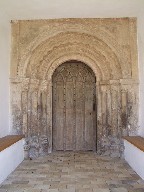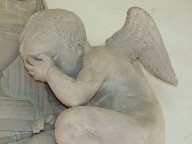| |
|
 |
|
St Mary sits away from its
village in the intensely agricultural
landscape of the Lowestoft hinterland. It
is extraordinary to think that we are
barely five miles from the centre of that
busy town. This
is an ancient place. The narrow lanes cut
deeply down into the old field pattern,
and this church sits beside a crossroads
on its circular mound of a graveyard,
obviously a pre-Christian pagan site.
And, as so often in Suffolk, you get
closer to what appears to be an elegant
work of substantially the 14th and 15th
Centuries, and find something more rugged
and earthy, for this is still at heart a
Norman church, with one of the best
Norman south doorways in Suffolk. You can
gaze out across the fields and copses,
imagining yourself to be at any time, if
it were not for the occasional car
storming up the by-road to Lowestoft.
You let yourself in south
doorway into an entirely rustic space,
redolent with age and the long
generations of its parish, but well cared
for, and obviously much loved.
|
There
is a musty smell of carpets and plaster, a
silence carried down the years. The nave and
chancel are continuous under one long roof. Not
much survives from before the 17th Century when a
major fire also destroyed the part of the village
that sat at this crossroads. St Mary probably
stood in ruins for the Commonwealth period, after
which the chancel was rebuilt in truncated form,
possibly for use as a school room. There was a
restoration in the 1840s, early for Suffolk but
late enough to be ecclesiologically correct, and
then a reordering in 1906. Mortlock mourns the
loss of the box pews at that time. He's right of
course, but our Georgian and Victorian ancestors
would still be quite at home here.
For
such a rural church, St Mary has more than its
fair share of good memorials. They date from the
18th and early 19th Centuries, and may have been
reset in the 1840s restoration. Two of them are
of interest for their material as much as for
their design, for they are made of Coade Stone
and are signed Coade & Sealy. Coade
Stone was a cement-based artificial stone which
was very much cheaper to produce than carved
marble, and memorials were made of it from the
1760s until the 1830s. One here is for Commander
William Clarke, and features a rather startling
porky cherub trying to conceal his grief. The
other is to George and Frances Mitchell who died
in the prime of their days within six weeks of
each other - it features a woman who appears
to be wrestling with a large urn, perhaps to stop
it falling. I can't think of another rural church
in Suffolk with two such memorials. Less alarming
is the memorial to Laurence Etchard of a century
earlier, its drapes rather more lifelike than the
bat-winged skull grinning at its base.
St
Mary displays a beautifully lettered roll of
honour, and there is a WWI cross to George
Frederick Farmiloe, who was killed near Arras in
France on 26th June 1917. It appears to be one of
the second generation crosses installed by the
then-Empire War Graves Commission when bodies
were collected together in larger cemeteries
after the war, rather than a battlefield cross.
George was the son of Thomas and Fanny Farmiloe
of Hampstead in London. The Farmiloes were
wealthy lead and glass merchants, and their
former factory in East London is regularly used
as a film set, standing in for the Gotham City
police headquarters in the latest Batman
film, an unlikely connection with this peaceful,
remote spot.
| The Farmiloe family bought
Henstead Hall in the 1950s, and
presumably this cross came with them and
was placed in the church then.
Incredibly, George Farmiloe's son Douglas
lived at Henstead Hall until he was into
his late nineties. In his autobiography A
Tarnished Silver Spoon he described
himself as a 'Mayfair Playboy' and
recorded that his happiest memories were
of being young in London, when I was spending money
in the West End... all the women,
that’s probably the best times.
Drink and women. Across
from his father's cross is a pleasing
proto-Art Deco memorial to Robert Harry
Inglis Palgrave, also of Henstead Hall.
He died in 1919, and is remembered in a
style which gives a nod to the earlier
memorials around him as a leader in
the study of economics, an example of
Christian citizenship and a man of
unwearied industry to whom Work was
Prayer, somewhat in contrast to the
Hall's later jolly resident.
|
|
 |
|
|
|

